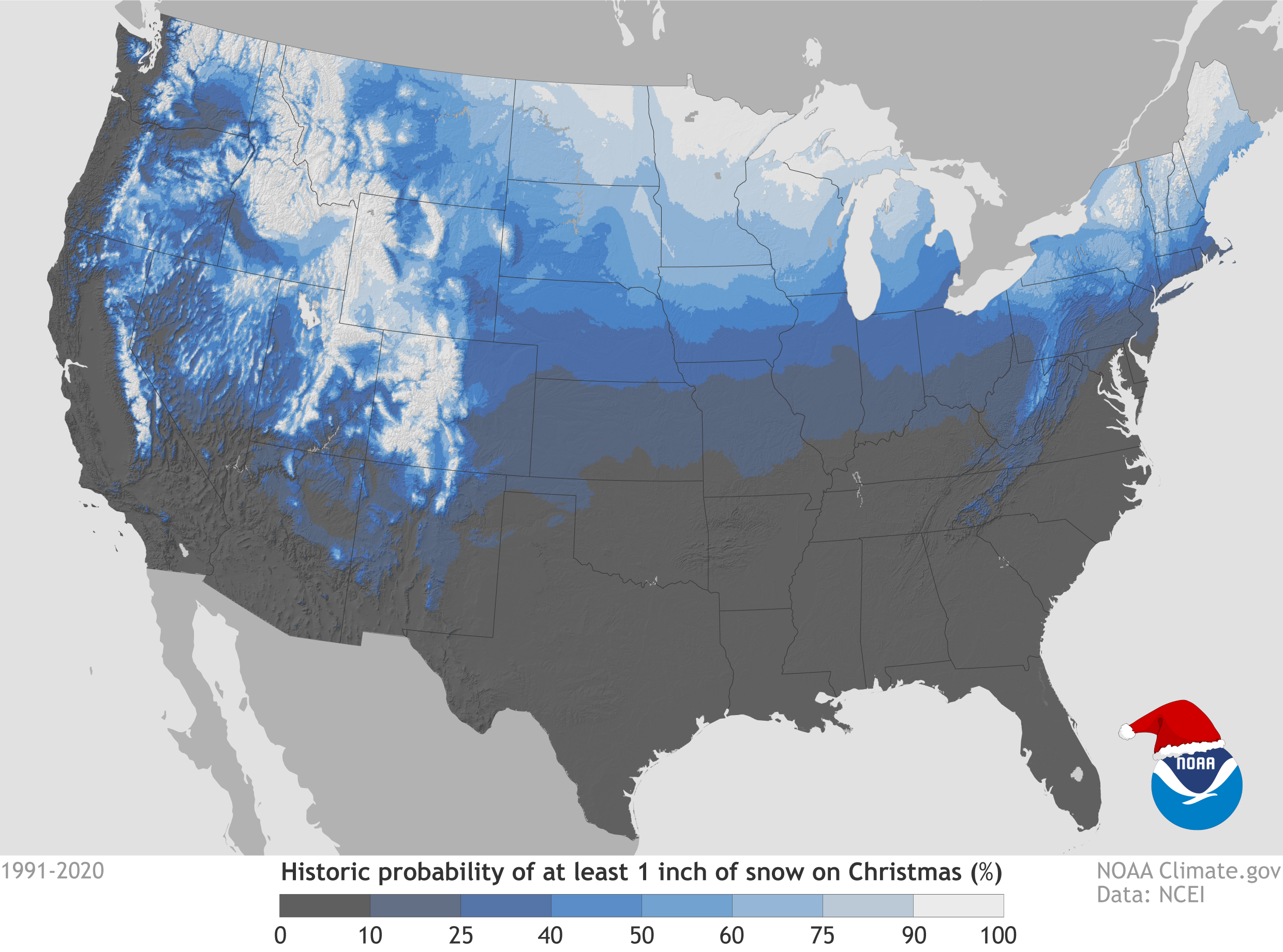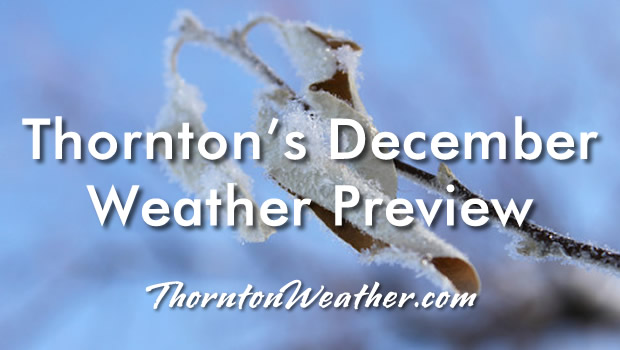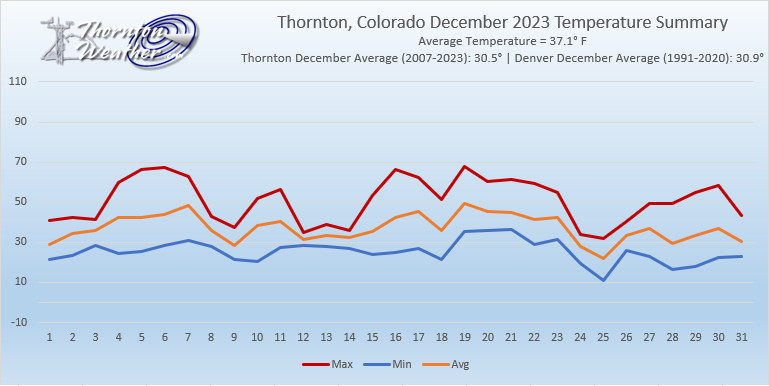
Extreme weather in December is hardly unusual as long-time residents can attest to. The most common major events involve wind, cold or snow and sometimes all three at once was we can see in our look back at this week in Denver weather history.
From the National Weather Service:
30-1
In 1929…heavy snow blanketed the city. Snowfall totaled 9.8 inches downtown. North winds were sustained to 32 mph with gusts to 37 mph on the 30th.
In 1970…high winds blasted Boulder and the eastern plains. In Boulder…a wind gust to 112 mph was recorded at the National Center for Atmospheric Research with a gust to 96 mph at the National Bureau of Standards.
In downtown Boulder…wind gusts reached 76 mph. At Stapleton International Airport…winds gusted to 47 mph. The high winds caused widespread light to moderate property damage across most of metro Denver. Roofs…signs…trees…power lines…and other property were damaged. Blowing dust reduced visibility to near zero over most of eastern Colorado. Several mobile homes…campers…and semi- trailers were blown off the highways north of Denver.
In 1985…an intrusion of cold arctic air into metro Denver resulted in setting 3 temperature records. The temperature climbed to only 17 degrees on the 30th…setting a record low maximum for the date. On the 1st…the temperature plunged to 6 degrees below zero…setting a record low for the date… And warmed to only 7 degrees…setting a record low maximum for the date.
30-2
In 1975…very strong Chinook winds up to 100 mph caused damage to homes…aircraft…aircraft hangars…mobile homes… Cars…and power lines along the eastern foothills. Strong northwest winds gusted to 39 mph at Stapleton International Airport on both the 30th and the 1st.
1
In 1899…northwest Chinook winds were sustained to 47 mph with gusts to 60 mph. The strong Chinook winds warmed the temperature to a high of 61 degrees…the warmest of the month. The low temperature dipped to only 39 degrees.
In 1972…strong Chinook winds gusted in excess of 65 mph in Boulder. There were no reports of damage. Northwest winds gusted to 38 mph at Stapleton International Airport.
In 1992…strong winds continued through the early morning hours. Wind gusts to over 70 mph were measured at reporting sites in the foothills west of Denver. In west Boulder…wind gusts reached 71 mph with 77 mph measured at Rollinsville. At Stapleton International Airport northwest winds gusted to 39 mph. The walker ranch…an historic site west of Boulder…burned down overnight during the high wind event. Although the winds did not cause the fire…they did hamper efforts to extinguish the blaze.
In 1996…high winds howled in and near the Front Range foothills. Winds gusted to 105 mph at Wondervu southwest of Boulder and to 70 mph at Jefferson County Airport near Broomfield. West winds gusted to only 24 mph at Denver International Airport.
1-2
In 1933…apparent post-frontal heavy snowfall totaled 8.0 inches across downtown Denver. North winds were sustained to 17 mph with an extreme velocity to 18 mph on the 1st.
In 1981 strong winds gusted to over 70 mph along the foothills. A peak gust to 100 mph was recorded at Wondervu. A gust to 94 mph was recorded just west of Boulder. Roofs on houses were damaged in the Evergreen area…and some mobile homes also were damaged. At Stapleton International Airport…northwest winds gusted 44 mph on the 1st and 37 mph on the 2nd.
1-5
In 1913…the 1st marked the start of the heaviest 5-day total snowfall in the city’s history. During this period snowfall totaled 45.7 inches. Starting on the 1st…snow fell intermittently for 3 days and accumulated a little over 8 inches. On the 4th and 5th…an additional 37.4 inches of snow fell. At Georgetown in the foothills west of Denver even more snow fell…86 inches over the 5 days with the most…63 inches…on the 4th. In Colorado…snowfall was heavy along the eastern slopes of the mountains from the Palmer Divide north. High winds during the storm caused heavy drifting…which blocked all transportation. Snow cover of an inch or more from the storm persisted for 60 consecutive days from the 1st through January 29…1914. Additional snowfall in December and January prolonged the number of days. This is the third longest period of snow cover on record in the city.
2
In 1893…northwest winds were sustained to 42 mph with gusts to 46 mph. Snowfall was only 1.4 inches in the city.
In 1895…0.01 inch of melted snow from 0.7 inch of snowfall was the only measurable precipitation of the month in downtown Denver…ranking the month the 3rd driest December on record.
In 1899…post-frontal northeast winds sustained to 44 mph with gusts to 59 mph caused the temperature to plunge from a high of 55 degrees to a low of 15 degrees. Snowfall was only 1.0 inch.
In 1902…apparent post-frontal northwest winds were sustained to 45 mph with gusts to 53 mph. A trace of snow fell.
In 1905…only a trace of snow fell in downtown Denver. This was the only snow and precipitation for the month… Ranking the month the second driest and the second least snowiest December on record.
In 1921…snowfall was 5.5 inches in downtown Denver. Northwest winds were sustained to 24 mph with an extreme velocity of 25 mph.
In 1951…a vigorous pacific cold front produced a northwest wind gust to 51 mph at Stapleton Airport where brief blowing dust was observed.
In 1957…a strong Pacific cold front produced northwest wind gusts to 54 mph at Stapleton Airport where the surface visibility was briefly reduced to 1 1/2 miles in blowing dust.
In 1977…high winds in Boulder lifted a warehouse from its foundation and ripped it apart. Wind gusts from 60 to 103 mph toppled and injured a man while walking. Winds were clocked to 104 mph at Nederland…100 mph at Morrison…and 62 mph at Rocky Flats. Northwest winds gusted to 41 mph at Stapleton International Airport.
In 1996…for the second day in a row high winds ripped the Front Range foothills. Winds gusted to 81 mph in Golden Gate Canyon. West-northwest winds gusted to 37 mph at Denver International Airport.
In 2013…high winds developed ahead of an approaching storm system. The strong winds downed several trees around Evergreen. Peak wind gusts included: 79 mph…4 miles west-southwest of Eldorado Springs; 78 mph…3 miles south of Evergreen; 75 mph and the NCAR Mesa Lab; and 69 mph in Longmont.
2-3
In 1955…snowfall totaled only 2.9 inches at Stapleton Airport. This was the only measurable snowfall of the month.
In 1973…post-frontal heavy snowfall totaled 7.6 inches at Stapleton International Airport where northeast winds gusting to 37 mph caused some blowing snow.
In 1990…strong downslope winds raked the eastern foothills and most of metro Denver. A wind gust to 87 mph was recorded at Rollinsville with wind gusts to 58 mph in Arvada and 55 mph in Lakewood. West winds gusted to 48 mph at Stapleton International Airport on the 2nd.
In 1997…heavy snow fell in the foothills. Conifer received 10 inches of new snow. Snowfall totaled only 2.4 inches at the site of the former Stapleton International Airport on the 1st…2nd…and 3rd. North winds gusted to 24 mph at Denver International Airport on the 2nd.
2-4
In 1909…post-frontal snowfall totaled 6.1 inches in downtown Denver. Most of the snow…5.9 inches…fell between 6:00 pm on the 2nd and 6:00 pm on the 3rd. North winds were sustained to 18 mph on both the 2nd and 3rd.
2-17
In 1939…more than 2 weeks of unseasonably warm weather made the month the 3rd warmest on record. Seven daily temperature records were set…including the all-time record high temperature for the month of 79 degrees on the 5th. Daytime highs were balmy with 14 days in the 60’s and 70’s. Low temperatures dipped to freezing or below on only 5 days. The period was dry with only a trace of snow on the 12th.
3
In 1977…high winds continued in Boulder and were clocked from 74 to 90 mph…causing only minor damage. Northwest winds gusted to 33 mph at Stapleton International Airport where the strong Chinook winds warmed the temperature to a high of 63 degrees.
In 1985…wind gusts to 78 mph were clocked at Table Mesa in Boulder. Winds gusted to 70 mph at Echo Lake west of Denver.
In 2011…another round of snow developed in and near the Front Range foothills. The heaviest snowfall occurred in the foothills of Boulder and northern Jefferson counties. Storm totals included: 13 inches…7 miles southwest of Boulder; 10.5 inches…4 miles east-northeast of Nederland; 10 inches at Genesee; 9.5 inches…4 miles west-northwest of Boulder; 9 inches at Gross Reservoir and 4 miles east of Pinecliffe. Around the urban corridor…storm totals ranged from 3 to 8 inches…heaviest in and around Boulder. At Denver International Airport…3 inches of snow fell.
3-4
In 1968…strong Chinook winds in Boulder gusting to 52 mph downtown caused 7 thousand dollars in damage. Flying debris damaged cars…houses…and other property in Boulder. West winds gusted to 49 mph late on the 3rd and to 45 mph on the 4th at Stapleton International Airport where the temperature climbed to a high of 60 degrees on the 4th.
In 1970…strong winds whistled through Boulder. Sustained winds of 40 mph with gusts to 70 mph were recorded at the National Bureau of Standards in Boulder. Wind gusts to 50 mph occurred in downtown Denver. No damage was reported. On the 3rd…northwest winds gusted to 40 mph at Stapleton International Airport where the Chinook winds warmed the temperature to a high of 66 degrees on the 4th.
In 1999…heavy snow fell over the foothills and metro Denver. The heaviest snowfall occurred in the foothills south of I-70 and near the Palmer Divide. Snowfall totals included: 25 inches near Tiny Town; 18 inches at Conifer; 15 inches near Evergreen; 14 inches at Chief Hosa…8 miles west of Castle Rock…and near Blackhawk; 12 inches at Pine Junction and 8 miles south of Sedalia; 11 inches atop Floyd Hill and in Roxborough; and 10 inches at Castle Rock. Around metro Denver…snowfall totals included: 10 inches at Highlands Ranch…9 inches at Parker…and 8 inches in Aurora and Wheat Ridge. Elsewhere around the metro area…snowfall generally ranged from 3 to 5 inches. Only 3.2 inches of snow fell at the site of the former Stapleton International Airport. North winds gusted to 32 mph at Denver International Airport on the 3rd.
In 2007…high winds developed in and near the Front Range foothills. Peak wind reports included: 88 mph atop Niwot Ridge; 87 mph atop Mines Peak; 80 mph…3 miles southeast of Jamestown; 78 mph at Longmont; 74 mph at Table Mesa. A few power outages occurred in Longmont as broken branches downed power lines. Northwest winds gusted to 38 mph at Denver International Airport on the 4th.
In 2013…a storm system brought heavy snow to parts of the Front Range Foothills. Storm totals included: 12 inches.. 7 miles west-southwest of Evergreen; 10.5 inches…3 miles north of Bailey; 9.5 inches…3 miles west of Jamestown and 5 miles northeast of Ward; 9 inches in Bailey…8.5 inches… 3 miles north of Conifer.
Continue reading December 1 to December 7: This Week in Denver Weather History →






































































